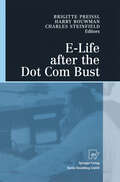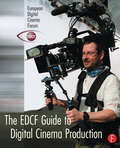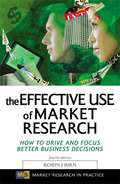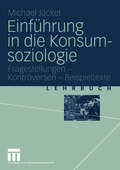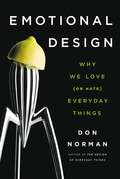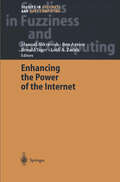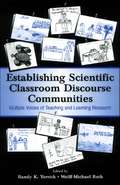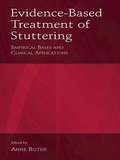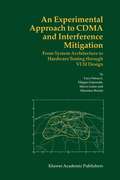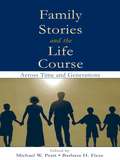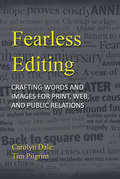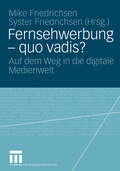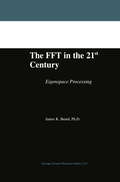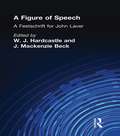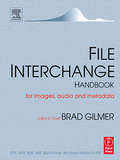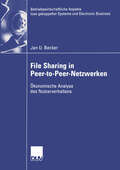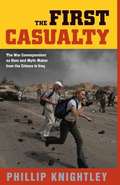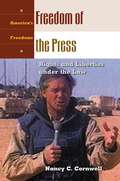- Table View
- List View
E-Life after the Dot Com Bust
by Brigitte Preissl Harry Bouwman Charles SteinfieldAfter the dramatic failures of the dot coms in 2000 and 2001, many observers were quick to report on the death of electronic commerce. Investor confidence sagged, stock prices of technology firms in nearly all of the related sectors suffered. In reality, the picture is not nearly as dismal as the press would have us believe. E-commerce is not dead, but it has moved beyond its overhyped beginning stage. This book is an effort to sort through the hype, providing a realistic assessment of the state of electronic commerce today, and the important areas of opportunity and challenge for tomorrow. The book sees all kind of developments where e-business is becoming an integral part of ‘traditional’ business processes, with special emphasis on practical and policy importance. E-commerce scholars from a number of disciplines and countries contribute to assess the impact of the dot com bust and the current state of e-commerce.
The EDCF Guide to Digital Cinema Production
by Lasse SvanbergA professional introduction to the end-to-end process of digital filmmaking!The EDCF Guide to Digital Cinema Production sheds light on the ongoing and confusing transition from analog to digital technology in film production. In addition to a complete analysis of technical concerns, this text deals with a number of issues where European and Hollywood priorities differ. It adds fuel to the discussion on "Photo-Chemical Fundamentalism" and the future of traditional film-based cinematography.With special emphasis on new HD production techniques for the big cinema screen, this guide is the one and only resource available from a European perspective. The EDCF Guide to Digital Cinema Production provides film professionals and decisions-makers in European cinema with an excellent basis for discussions on how to handle the transition from analog to digital technology. Look no further for:* Several production case studies, among them Ingmar Bergman's last film "Saraband" (2003) and Lars von Trier's "Dogville" (2003).* Surveys of HD Systems & Cameras and "The 37 MFAQ on HD Production."* Expert reports on Audio Recording for HD and the Digital Intermediate Process.* Detailed European initiatives in Digital Cinema.* An up-to-date survey of the problematic standards situation for Digital Cinema.* A comprehensive look at archiving - the "Achilles Heel" of digital production.* The pros and cons of producing feature films digitally - a unique and professional view of "the agony and ecstacy."Editor-in-Chief Lasse Svanberg is a founding member of EDCF. He was DoP on 14 feature films 1966-81, founded TM (Technolgy & Man) Magazine at the Swedish Film Institute in 1968 and was its Chief Editor until 1998 He was elected Fellow of BKSTS 1979, Fellow of SMPTE 1995 and granted Professor's title by the Swedish Government 2002. He is the author of six books on the history and possible future of film, video and television.The European Digital Digital Cinema Forum (EDCF) was constituted in June 2001 as joint Swedish-British-French effort to establish a European forum for discussions, information exchange and industrial activities in the field of Digital Cinema. This project was initiated because digital production, digital distribution and digital exhibition of film is the most radical technical change facing the film industry since sound film was introduced.
The EDCF Guide to Digital Cinema Production
by Lars SvanbergA professional introduction to the end-to-end process of digital filmmaking!The EDCF Guide to Digital Cinema Production sheds light on the ongoing and confusing transition from analog to digital technology in film production. In addition to a complete analysis of technical concerns, this text deals with a number of issues where European and Hollywood priorities differ. It adds fuel to the discussion on "Photo-Chemical Fundamentalism" and the future of traditional film-based cinematography.With special emphasis on new HD production techniques for the big cinema screen, this guide is the one and only resource available from a European perspective. The EDCF Guide to Digital Cinema Production provides film professionals and decisions-makers in European cinema with an excellent basis for discussions on how to handle the transition from analog to digital technology. Look no further for:* Several production case studies, among them Ingmar Bergman's last film "Saraband" (2003) and Lars von Trier's "Dogville" (2003).* Surveys of HD Systems & Cameras and "The 37 MFAQ on HD Production."* Expert reports on Audio Recording for HD and the Digital Intermediate Process.* Detailed European initiatives in Digital Cinema.* An up-to-date survey of the problematic standards situation for Digital Cinema.* A comprehensive look at archiving - the "Achilles Heel" of digital production.* The pros and cons of producing feature films digitally - a unique and professional view of "the agony and ecstacy."Editor-in-Chief Lasse Svanberg is a founding member of EDCF. He was DoP on 14 feature films 1966-81, founded TM (Technolgy & Man) Magazine at the Swedish Film Institute in 1968 and was its Chief Editor until 1998 He was elected Fellow of BKSTS 1979, Fellow of SMPTE 1995 and granted Professor's title by the Swedish Government 2002. He is the author of six books on the history and possible future of film, video and television.The European Digital Digital Cinema Forum (EDCF) was constituted in June 2001 as joint Swedish-British-French effort to establish a European forum for discussions, information exchange and industrial activities in the field of Digital Cinema. This project was initiated because digital production, digital distribution and digital exhibition of film is the most radical technical change facing the film industry since sound film was introduced.
The Effective Use of Market Research: Volume 4 (4th edition) (PDF)
by Robin BirnMore and more companies today are using market research techniques, not just to find new markets, products and customers, but also to improve management and marketing decision making and to monitor customer service. The Effective Use of Market Research looks at the circumstances in which market research is necessary, and explains what management can expect to gain from research and then analyses the type of business decisions that may be taken as a result. An organization that knows its customers and monitors its activity well, and also has a good understanding of the key research techniques it needs, is likely to develop more competitive sales, marketing and communications strategies.This latest edition of Effective Use of Market Research explains how to develop representative samples, data protection legislation and the professional ethics incorporated in the MRS Code of Conduct.
Einführung in die Konsumsoziologie: Fragestellungen - Kontroversen - Beispieltexte
by Michael JäckelDie moderne Gesellschaft lässt sich als Konsumgesellschaft beschreiben. Mode, Geschmack, Stil sind ebenso prägend wie die mit der entstehenden Konsumgesellschaft einhergehende Konsumkritik. Dieses einführende Lehrbuch beschreibt daher die Entstehung und Entwicklung von Konsum und seine gesellschaftliche Bedeutung.
Emotional Design: Why We Love (or Hate) Everyday Things
by Don NormanWhy attractive things work better and other crucial insights into human-centered designEmotions are inseparable from how we humans think, choose, and act. In Emotional Design, cognitive scientist Don Norman shows how the principles of human psychology apply to the invention and design of new technologies and products. In The Design of Everyday Things, Norman made the definitive case for human-centered design, showing that good design demanded that the user's must take precedence over a designer's aesthetic if anything, from light switches to airplanes, was going to work as the user needed. In this book, he takes his thinking several steps farther, showing that successful design must incorporate not just what users need, but must address our minds by attending to our visceral reactions, to our behavioral choices, and to the stories we want the things in our lives to tell others about ourselves. Good human-centered design isn't just about making effective tools that are straightforward to use; it's about making affective tools that mesh well with our emotions and help us express our identities and support our social lives. From roller coasters to robots, sports cars to smart phones, attractive things work better. Whether designer or consumer, user or inventor, this book is the definitive guide to making Norman's insights work for you.
Enhancing the Power of the Internet (Studies in Fuzziness and Soft Computing #139)
by Ben Azvine Ronald R. Yager Lofti A. Zadeh Masoud NikraveshThis book presents reports from the forefront of soft computing in the Internet industry and covers important topics in the field such as search engines, fuzzy query, decision analysis and support systems as well as e-business and e-commerce.
Establishing Scientific Classroom Discourse Communities: Multiple Voices of Teaching and Learning Research
by Randy K. Yerrick Wolff-Michael RothEstablishing Scientific Classroom Discourse Communities: Multiple Voices of Teaching and Learning Research is designed to encourage discussion of issues surrounding the reform of classroom science discourse among teachers, teacher educators, and researchers. The contributors--some of the top educational researchers, linguists, and science educators in the world--represent a variety of perspectives pertaining to teaching, assessment, research, learning, and reform. As a whole the book explores the variety, complexity, and interconnectivity of issues associated with changing classroom learning communities and transforming science classroom discourse to be more representative of the discourse of scientific communities. The intent is to expand debate among educators regarding what constitutes exemplary scientific speaking, thinking, and acting. This book is unparalleled in discussing current reform issues from sociolinguistic and sociocultural perspectives. The need for a revised perspective on enduring science teaching and learning issues is established and a theoretical framework and methodology for interpreting the critique of classroom and science discourses is presented. To model and scaffold this ongoing debate, each chapter is followed by a "metalogue" in which the chapter authors and volume editors critique the issues traversed in the chapter by opening up the neatly argued issues. These "metalogues" challenge, extend, and deepen the arguments made. Central questions addressed include: *Why is a sociolinguistic interpretation essential in examining science education reform? *What are key similarities and differences between classroom and scientific communities? *How can the utility of common knowledge and existing classroom discourse be balanced toward alternative outcomes? *What curricular issues are associated with transforming classroom talk? *What other perspectives can assist in creating multiple access to science through redefining classroom discourse? Whether this volume improves readers' science teaching, assists their research, or helps them to better prepare tomorrow's science teachers, the goal is to engage them in considering the challenges faced by educators as they navigate the seas of reform and strive to improve science education for all.
Establishing Scientific Classroom Discourse Communities: Multiple Voices of Teaching and Learning Research
by Randy Yerrick Wolff-Michael RothEstablishing Scientific Classroom Discourse Communities: Multiple Voices of Teaching and Learning Research is designed to encourage discussion of issues surrounding the reform of classroom science discourse among teachers, teacher educators, and researchers. The contributors--some of the top educational researchers, linguists, and science educators in the world--represent a variety of perspectives pertaining to teaching, assessment, research, learning, and reform. As a whole the book explores the variety, complexity, and interconnectivity of issues associated with changing classroom learning communities and transforming science classroom discourse to be more representative of the discourse of scientific communities. The intent is to expand debate among educators regarding what constitutes exemplary scientific speaking, thinking, and acting. This book is unparalleled in discussing current reform issues from sociolinguistic and sociocultural perspectives. The need for a revised perspective on enduring science teaching and learning issues is established and a theoretical framework and methodology for interpreting the critique of classroom and science discourses is presented. To model and scaffold this ongoing debate, each chapter is followed by a "metalogue" in which the chapter authors and volume editors critique the issues traversed in the chapter by opening up the neatly argued issues. These "metalogues" challenge, extend, and deepen the arguments made. Central questions addressed include: *Why is a sociolinguistic interpretation essential in examining science education reform? *What are key similarities and differences between classroom and scientific communities? *How can the utility of common knowledge and existing classroom discourse be balanced toward alternative outcomes? *What curricular issues are associated with transforming classroom talk? *What other perspectives can assist in creating multiple access to science through redefining classroom discourse? Whether this volume improves readers' science teaching, assists their research, or helps them to better prepare tomorrow's science teachers, the goal is to engage them in considering the challenges faced by educators as they navigate the seas of reform and strive to improve science education for all.
Evidence-Based Treatment of Stuttering: Empirical Bases and Clinical Applications
by Anne K. BotheThis book is the result of a "State-of-the-Art-Conference" held at the University of Georgia dedicated to the evidence-based treatment of stuttering. An international group of prominent fluency researchers and clinicians were invited to present and discuss current data and issues related to the treatment of stuttering. The topic was defined to include evidence about stuttering, evidence about stuttering treatment, and discussions of how that evidence should guide the continuing research and practice. The explicit link between empirical evidence and suggestions for clinical practice is the goal of the book. The book begins by addressing the notion of "evidence-based practice" and considers its implications for stuttering treatment. Part II presents the intersection of the nature of stuttering; the theories of stuttering; and the implications of nature, theory, and other knowledge for stuttering treatment decisions. Part III provides two of the many measurement issues facing stuttering treatment followed by Part IV, which is devoted to the quality of treatment research evidence, for specific treatments and in terms of some more general methodological and professional issues. The final part summarizes the clinical recommendations made throughout the book and discusses evidence-based, outcomes-focused clinical decisions for stuttering. These chapters are intended to provide "state-of-the-art" information to researchers, clinicians, and students who are interested in developing, identifying, or using the best possible evidence-based treatments for stuttering.
Evidence-Based Treatment of Stuttering: Empirical Bases and Clinical Applications
by Anne K. BotheThis book is the result of a "State-of-the-Art-Conference" held at the University of Georgia dedicated to the evidence-based treatment of stuttering. An international group of prominent fluency researchers and clinicians were invited to present and discuss current data and issues related to the treatment of stuttering. The topic was defined to include evidence about stuttering, evidence about stuttering treatment, and discussions of how that evidence should guide the continuing research and practice. The explicit link between empirical evidence and suggestions for clinical practice is the goal of the book. The book begins by addressing the notion of "evidence-based practice" and considers its implications for stuttering treatment. Part II presents the intersection of the nature of stuttering; the theories of stuttering; and the implications of nature, theory, and other knowledge for stuttering treatment decisions. Part III provides two of the many measurement issues facing stuttering treatment followed by Part IV, which is devoted to the quality of treatment research evidence, for specific treatments and in terms of some more general methodological and professional issues. The final part summarizes the clinical recommendations made throughout the book and discusses evidence-based, outcomes-focused clinical decisions for stuttering. These chapters are intended to provide "state-of-the-art" information to researchers, clinicians, and students who are interested in developing, identifying, or using the best possible evidence-based treatments for stuttering.
An Experimental Approach to CDMA and Interference Mitigation: From System Architecture to Hardware Testing through VLSI Design
by Luca Fanucci Marco Luise Filippo Giannetti Massimo RoviniAn Experimental Approach to CDMA and Interference Mitigation was written with the admittedly ambitious intent of filling the gap between communication theory and VLSI implementation, and thus to provide a more general/theoretical approach to the design, development, and testing of a CDMA receiver. As a consequence, the concepts and techniques that are presented turn out to be applicable to a more general kind of digital wireless modems in terms of receiver architecture design and implementation. As the reader will easily find out, the subject of digital modem design and implementation is addressed in the book starting from a theoretical approach (supported by proper bibliographic references), and is followed by application issues, with reference to an ESA experiment assumed as a case study. A complete design flow, from specification to implementation, including testing and final verification is then presented. This leads the reader step-by-step to a thorough understanding of CDMA transmission and detection, and constitutes a practical guidance for the design of VLSI wireless mobile terminals.
Family Stories and the Life Course: Across Time and Generations
by Michael W. Pratt Barbara H. FieseThis edited book draws from work that focuses on the act of telling family stories, as well as their content and structure. The process of telling family stories is linked to central aspects of development, including language acquisition, affect regulation, and family interaction patterns. This book extends across traditional developmental psychology, personality theory, and family studies. Drawing broadly on the epigenetic framework for individual development articulated by Erik Erikson, as well as on conceptions of the family life cycle, the editors bring together contemporary examples of psychological research on family stories and their implications for development and change at different points in the life course. The book is divided into sections that focus on family stories at different points in the life cycle, from early childhood and the beginnings of narrative skill, through adolescence, young adulthood, midlife, and then mature adulthood and its intergenerational meaning. During each of these periods of the life cycle, research focusing on individual development within an Eriksonian framework of ego strengths and virtues is highlighted. The dynamic role of family stories is also featured here, with work exploring the links between family process, intergenerational attachment, and storytelling. Sociocultural theories that emphasize how such development is situated in the wider cultural context are also featured in several chapters. This broad lifespan developmental focus serves to integrate the exciting diversity of this work and foster further questions and research in the emerging field of family narrative. The book is intended primarily for researchers and advanced-level students in the fields of developmental and personality psychology, as well as those in family studies and in gerontology. It may also be of interest to those in the helping professions who are concerned with family therapy and family issues, and may--due to its content and illustrative material--have appeal to a wider market of the lay public. The chapters are written in a readily accessible style and the analyses are presented in a fairly non-technical way. Because family stories are charted across the lifespan, it would be a suitable companion book to a more traditional lifespan textbook in certain courses.
Family Stories and the Life Course: Across Time and Generations
by Michael W. Pratt Barbara H. FieseThis edited book draws from work that focuses on the act of telling family stories, as well as their content and structure. The process of telling family stories is linked to central aspects of development, including language acquisition, affect regulation, and family interaction patterns. This book extends across traditional developmental psychology, personality theory, and family studies. Drawing broadly on the epigenetic framework for individual development articulated by Erik Erikson, as well as on conceptions of the family life cycle, the editors bring together contemporary examples of psychological research on family stories and their implications for development and change at different points in the life course. The book is divided into sections that focus on family stories at different points in the life cycle, from early childhood and the beginnings of narrative skill, through adolescence, young adulthood, midlife, and then mature adulthood and its intergenerational meaning. During each of these periods of the life cycle, research focusing on individual development within an Eriksonian framework of ego strengths and virtues is highlighted. The dynamic role of family stories is also featured here, with work exploring the links between family process, intergenerational attachment, and storytelling. Sociocultural theories that emphasize how such development is situated in the wider cultural context are also featured in several chapters. This broad lifespan developmental focus serves to integrate the exciting diversity of this work and foster further questions and research in the emerging field of family narrative. The book is intended primarily for researchers and advanced-level students in the fields of developmental and personality psychology, as well as those in family studies and in gerontology. It may also be of interest to those in the helping professions who are concerned with family therapy and family issues, and may--due to its content and illustrative material--have appeal to a wider market of the lay public. The chapters are written in a readily accessible style and the analyses are presented in a fairly non-technical way. Because family stories are charted across the lifespan, it would be a suitable companion book to a more traditional lifespan textbook in certain courses.
Fearless Editing: Crafting Words and Images for Print, Web, and Public Relations
by Carolyn Dale Tim PilgrimFearless Editing clearly articulates the basic concepts underlying editing techniques and demonstrates their application for newspapers, public relations, magazines and Web pages. This text takes a conceptual approach that integrates verbal skills with visual elements. Unlike other texts that are clearly designed for print, this book includes multi-media applications in every chapter.
Fearless Editing: Crafting Words and Images for Print, Web, and Public Relations
by Tim Pilgrim Carolyn DaleFearless Editing clearly articulates the basic concepts underlying editing techniques and demonstrates their application for newspapers, public relations, magazines and Web pages. This text takes a conceptual approach that integrates verbal skills with visual elements. Unlike other texts that are clearly designed for print, this book includes multi-media applications in every chapter.
Fernsehwerbung — quo vadis?: Auf dem Weg in die digitale Medienwelt
by Mike Friedrichsen Syster FriedrichsenIm Mittelpunkt des Bandes stehen die Essentials, also die Entwicklungsperspektiven, die Ökonomie, die Glaubwürdigkeit sowie die Frage nach dem grundsätzlichen Sinn von Fernsehwerbung. Darüber hinaus sollen diverse besondere Formen der Fernsehwerbung diskutiert werden, so z.B. virtuelle Werbung. Ein wesentlicher Punkt ist auch die Frage nach der Bedeutung der Fernsehwerbung im digitalen Zeitalter, wobei sich die Frage nach neuen - technischen - Möglichkeiten genauso wie die nach der Akzeptanz beim Publikum stellt. Abschließend soll geprüft werden, ob es überhaupt Konzepte für die Zukunft der Fernsehwerbung gibt und wie diese zu bewerten sind.
The FFT in the 21st Century: Eigenspace Processing
by James K. BeardThis book was undertaken to provide a text and reference on the theory and practice of the FFT and its common usage. This book is organized in only four chapters, and is intended as a tutorial on the use of the FFf and its trade space. The trade space of the FFT is the parameters in its usage and the relationships between them - the sampie rate, the total number of points or the interval over which processing occurs in a single FFf, the selectivity of tuning to a given frequency over signals out-of-band, and the bandwidth over which a signal appears. The examples given in this text are in FORTRAN 9512003. FORTRAN 2003 was frozen as a standard while this work was in progress. The listings given here are intended as an aid in understanding the FFT and associated algorithms such as spectral window weightings, with the goal of making the best of them more accessible to the reader. The code I use here provides a simple bridge between the material in the text and implementation in FORTRAN 2003, C++, Java, MATLAB ©, and other modem languages. The examples are sufficiently simple to be translated into older languages such as C and FORTRAN 77 if desired.
A Figure of Speech: A Festschrift for John Laver
by W. J. Hardcastle J. Mackenzie BeckThroughout the world, there are phoneticians who have been influenced by the teaching, research, and writings of John Laver. Many have worked with him personally, and most of the contributors to this book are people with whom he has had special links or whose involvement represents an appreciation of the breadth of Laver's interests. While the book is meant to be a tribute to John Laver, the topics have been chosen to provide an overview of some key issues in phonetics, with illuminating contributions from some of the most influential academics in the field. Contributing to this festschrift are William Hardcastle, Janet Mackenzie Beck, Peter Ladefoged, John J. Ohala, F. Gibbon, Anne Cutler, Mirjam Broersma, Helen Fraser, Peter F. MacNeilage, Barbara L. Davis, R. E. Asher, E. L. Keane, G. J. Docherty, P. Foulkes, Janet Fletcher, Catherine Watson, John Local, Ailbhe Ní Chasaide, Christer Gobl, John H. Esling, Jimmy G. Harris, and Francis Nolan.
A Figure of Speech: A Festschrift for John Laver
by William J. Hardcastle Janet Mackenzie BeckThroughout the world, there are phoneticians who have been influenced by the teaching, research, and writings of John Laver. Many have worked with him personally, and most of the contributors to this book are people with whom he has had special links or whose involvement represents an appreciation of the breadth of Laver's interests. While the book is meant to be a tribute to John Laver, the topics have been chosen to provide an overview of some key issues in phonetics, with illuminating contributions from some of the most influential academics in the field. Contributing to this festschrift are William Hardcastle, Janet Mackenzie Beck, Peter Ladefoged, John J. Ohala, F. Gibbon, Anne Cutler, Mirjam Broersma, Helen Fraser, Peter F. MacNeilage, Barbara L. Davis, R. E. Asher, E. L. Keane, G. J. Docherty, P. Foulkes, Janet Fletcher, Catherine Watson, John Local, Ailbhe Ní Chasaide, Christer Gobl, John H. Esling, Jimmy G. Harris, and Francis Nolan.
File Interchange Handbook: For professional images, audio and metadata
by Brad GilmerThe authoritative work on file formats for global film and television!The FILE INTERCHANGE HANDBOOK is a must-have reference for every film and video professional moving to computer based production and distribution. It is the only book that gives a complete scrutiny and breakdown of all file formats for the transfer of images, sound and metadata. Geared to a global audience, this text will get you the information that you need to learn this brand-new technology. Upcoming industry trends are mapped out alongside technology standards in this complete guide.Learn the purpose, functionality, and structure of each standard format with this single major reference on file interchange. This handbook is the one-stop resource you want for this essential technology.Table of contents:Intro--Brad Gilmer, Gilmer & Associates, Inc. 1. History / background--Hans Hoffman, EBU 2. Metadata dictionary--Oliver Morgan, Metaglue Corporation 3. Digital Picture eXchange (DPX)--Dave Bancroft, Thomson 4. General eXchange Format (GXF)--Bob Edge and Ray Baldock, Thomson Grass Valley 5. Material eXchange Format (MXF)--Jim Wilkinson, Sony, and Bruce Devlin, Snell & Wilcox, Ltd 6. Advanced Authoring Format (AAF)--Phil Tudor, BBC 7. Windows Media 9-Advanced System Format (ASF)--Nick Vicars-Harris, Microsoft Corporation 8. Apple QuickTime--George Towner, Apple Computer, Inc.Praise for the File Interchange Handbook:"Brad Gilmer has assembled a timely and valuable reference work covering the technical and structural aspects of file formats and wrappers used for processing program content. The book provides a clear, concise description of the file wrappers together with valuable background and applications information. It has been tailored for the practicing engineer and technical manager. Chapters on the SMPTE Metadata Dictionary and the Advanced Authoring Format are particularly relevant. This book is a valuable reference work for every practicing broadcast and teleproduction engineer, every Information Technology professional, and those in the telecommunications field who are actively involved in the manufacturing, management, transport or delivery of media and entertainment content." - Gavin Schutz, Chief Technology Officer, Ascent Media Group "I found this book to be an excellent up to date reference manual and a "must read" for anyone currently involved in the design and implementation of multimedia facilities. It helped me to gain a better understanding of issues that must be addressed as we transition our stations from traditional base band audio video environments to a file based IT infrastructures." - Ira Goldstone, VP chief technology officer Tribune Broadcasting "In the mid '90s, CNN and other broadcasters recognized the need for standardized file exchange of broadcast material. Our technology plans mapped a path to an integrated production environment that was based on video files instead of video streams. With these new systems, we wanted to ensure that we could continue to leverage the best technology for the various parts of our production systems while taking advantage of more efficient content access. This created a strong need for open, standardized methods of exchanging video files that would support a variety of compressions and Metadata. These protocols needed to handle everything from simple file exchange to complex authoring formats for content in active production. Because of these needs, CNN pushed the industry to create several of the formats discussed in detail in this book and provided active user requirements during their creation. Within the next year, CNN will have systems in place that use MXF for file exchange between our p
File Interchange Handbook: For professional images, audio and metadata
by Brad GilmerThe authoritative work on file formats for global film and television!The FILE INTERCHANGE HANDBOOK is a must-have reference for every film and video professional moving to computer based production and distribution. It is the only book that gives a complete scrutiny and breakdown of all file formats for the transfer of images, sound and metadata. Geared to a global audience, this text will get you the information that you need to learn this brand-new technology. Upcoming industry trends are mapped out alongside technology standards in this complete guide.Learn the purpose, functionality, and structure of each standard format with this single major reference on file interchange. This handbook is the one-stop resource you want for this essential technology.Table of contents:Intro--Brad Gilmer, Gilmer & Associates, Inc. 1. History / background--Hans Hoffman, EBU 2. Metadata dictionary--Oliver Morgan, Metaglue Corporation 3. Digital Picture eXchange (DPX)--Dave Bancroft, Thomson 4. General eXchange Format (GXF)--Bob Edge and Ray Baldock, Thomson Grass Valley 5. Material eXchange Format (MXF)--Jim Wilkinson, Sony, and Bruce Devlin, Snell & Wilcox, Ltd 6. Advanced Authoring Format (AAF)--Phil Tudor, BBC 7. Windows Media 9-Advanced System Format (ASF)--Nick Vicars-Harris, Microsoft Corporation 8. Apple QuickTime--George Towner, Apple Computer, Inc.Praise for the File Interchange Handbook:"Brad Gilmer has assembled a timely and valuable reference work covering the technical and structural aspects of file formats and wrappers used for processing program content. The book provides a clear, concise description of the file wrappers together with valuable background and applications information. It has been tailored for the practicing engineer and technical manager. Chapters on the SMPTE Metadata Dictionary and the Advanced Authoring Format are particularly relevant. This book is a valuable reference work for every practicing broadcast and teleproduction engineer, every Information Technology professional, and those in the telecommunications field who are actively involved in the manufacturing, management, transport or delivery of media and entertainment content." - Gavin Schutz, Chief Technology Officer, Ascent Media Group "I found this book to be an excellent up to date reference manual and a "must read" for anyone currently involved in the design and implementation of multimedia facilities. It helped me to gain a better understanding of issues that must be addressed as we transition our stations from traditional base band audio video environments to a file based IT infrastructures." - Ira Goldstone, VP chief technology officer Tribune Broadcasting "In the mid '90s, CNN and other broadcasters recognized the need for standardized file exchange of broadcast material. Our technology plans mapped a path to an integrated production environment that was based on video files instead of video streams. With these new systems, we wanted to ensure that we could continue to leverage the best technology for the various parts of our production systems while taking advantage of more efficient content access. This created a strong need for open, standardized methods of exchanging video files that would support a variety of compressions and Metadata. These protocols needed to handle everything from simple file exchange to complex authoring formats for content in active production. Because of these needs, CNN pushed the industry to create several of the formats discussed in detail in this book and provided active user requirements during their creation. Within the next year, CNN will have systems in place that use MXF for file exchange between our p
File Sharing in Peer-to-Peer-Netzwerken: Ökonomische Analyse des Nutzerverhaltens (Betriebswirtschaftliche Aspekte lose gekoppelter Systeme und Electronic Business)
by Jan BeckerJan U. Becker untersucht, welche Gründe Nutzer zu einem Angebot in File-Sharing-Netzwerken bewegen und wie diese sich in Abhängigkeit von Nutzereigenschaften darstellen. Er zeigt, wie Unternehmen der Medienindustrie mit legalen Angeboten von Downloads konkurrenzfähig sein können.
The First Casualty: The War Correspondent As Hero And Myth-maker From The Crimea To Iraq
by Phillip Knightley[Amazon} "The first casualty when war comes, is truth," said American Senator Hiram Johnson in 1917. In his gripping, now-classic history of war journalism, Phillip Knightley shows just how right Johnson was. From William Howard Russell, who described the appalling conditions of the Crimean War in the Times of London, to the ranks of reporters, photographers, and cameramen who captured the realities of war in Vietnam, The First Casualty tells a fascinating story of heroism and collusion, censorship and suppression. Since Vietnam, Knightley reveals, governments have become much more adept at managing the media, as highlighted in chapters on the Falklands War, the Gulf War, and the conflict between NATO and Serbia over Kosovo. And in a new chapter on the post-9/11 wars in Afghanistan and Iraq, Knightley details even greater degrees of government manipulation and media complicity, as evidenced by the "embedding" of reporters in military units and the uncritical, openly patriotic coverage of these conflicts. "The age of the war correspondent as hero," he concludes, "appears to be over." Fully updated, The First Casualty remains required reading for anyone concerned about freedom of the press, journalistic responsibility, and the nature of modern warfare.
Freedom of the Press: Rights and Liberties under the Law (America's Freedoms)
by Nancy C. CornwellAn authoritative yet accessible analysis of the historical development and contemporary scope of press freedoms in America.Freedom of the Press: Rights and Liberties under the Law examines the evolution of press freedom in America, a particularly relevant topic given the controversy over the role of the press in the war in Iraq, as well as the growing concentration of ownership of the press, and the impact of the Internet on traditional journalism. An opening analysis of challenges from recent developments like Internet journalist Matt Drudge's "Drudge Report" illustrates the opportunities and implications of a press operating without the traditional gate-keeping process.A historical overview of philosophical ideas and English traditions precedes an exploration into the judicial, regulatory, social, political, and economic developments that have shaped press freedoms, addressing such issues as libel, free press versus fair trial, and access to courtrooms. A chapter is devoted to the impact of new communication and transmission technology such as videophones and satellites.
